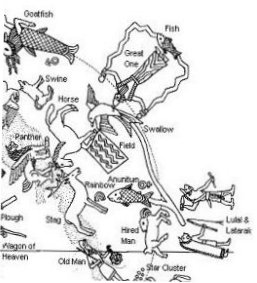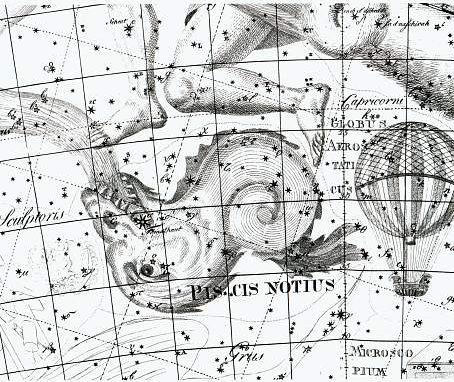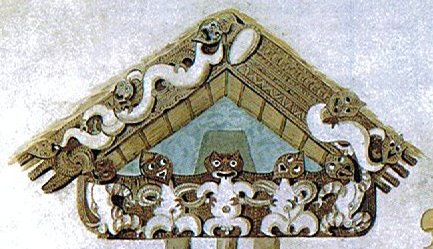5. I think we can be fairly certain that Gb2-16 is located in the season of Aquarius. However, instead of a man sending down a single great torrent we can see flows running on both sides of the central pu sign:
In Babylonia the corresponding sign was the Great One (Aquarius), a man with currents running on both sides:
He is in the center of the 1st quadrant of the Sun year and his position is in the 'water'. Nowadays Aquarius has moved closer to spring equinox (= autumn equinox south of the equator). The Great One is standing on the Fish, which presumably corresponds the ancient Southern Fish, because she is looking in the direction of winter solstice. The hole at bottom in pu could correspond to the hole in Piscis Notius (probably inherited from the older fish):
Another fish, Anuntun(?), is rising towards Rainbow, and it is at the end of one of the bifurcation paths which could illustrate how sky and earth are separating in spring. The other bifurcation path ends with a Swallow. In this early time Pisces was not yet at spring equinox. "In early legend our australis was the parent of the zodiacal two, and has always been known under this specific title, varied by the other adjectives of equivalent signification, austrinus, meridionalis, and notius." (Allen) I cannot find any explanation of Anuntun (which possibly - it is hard to read - could be the name of the fish looking at Rainbow), and in Allen I can read why: "Kaus Borealis, the Northern (part of the) Bow, was Al Tizini's Rā'i al Na'āīm, the Keeper of the Na'ams, the uncertainty as to the meaning of which has already been noticed; but Kazwini evidently understood by it Ostriches, for in his list it is, with the stars μ, Al Thalimain, plainly meaning these desert birds. With the same stars it may have been the Akkadian Anu-ni-tum, said to have been associated with the great goddess Istar." Thus the fish Anu-ni-tum has the Rainbow in front and the sign of Venus at her back. Another mystery is evidently solved here too, viz. the star name Toliman (α Centauri). I think it is a corruption of the Arabic Al Thalimain, The Ostriches. The ostrich is a peculiar bird because it keeps its head down in the sand, unable to see anything. I suspect it illustrates how Sun late in the year is moving closer and closer to the horizon, threatening to disappear completely - which it does in midwinter for an observer close to the pole. The ostrich has a very great egg which could symbolize Sun at winter solstice:
The ostrich has a long neck and when its head is down in the ground its shape becomes that of an arch. |
||||||||||||||||||||||||||||||





